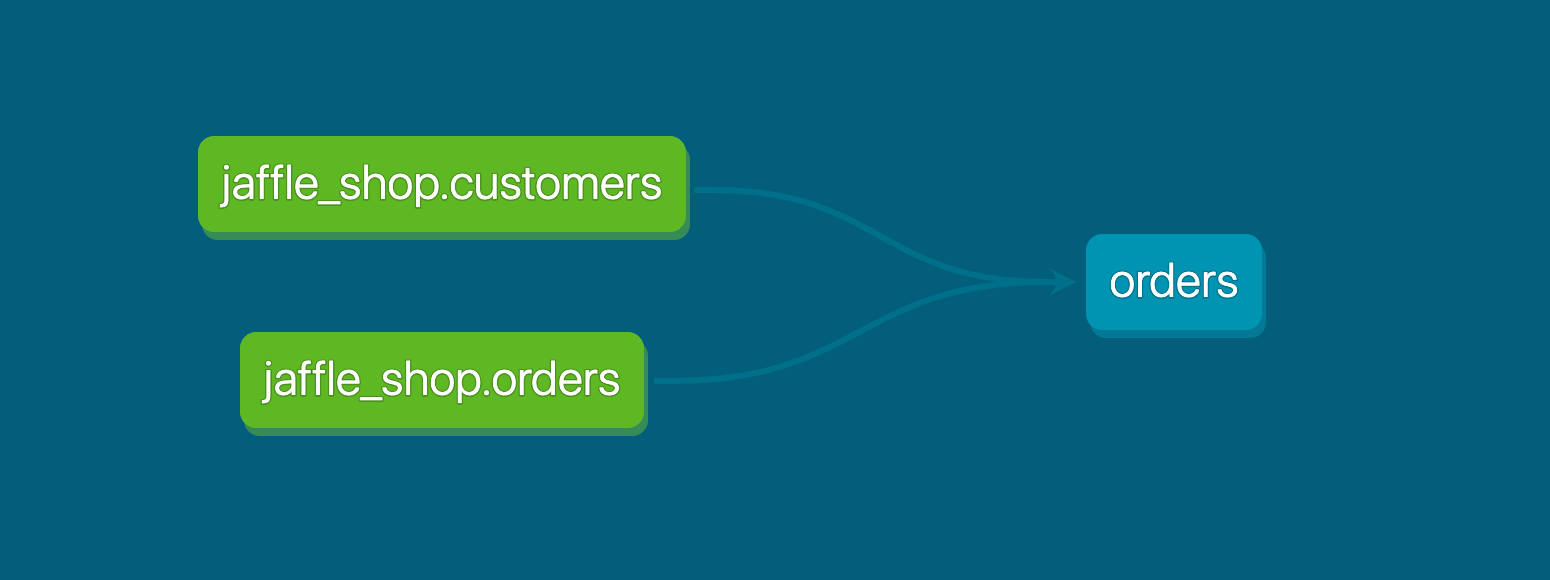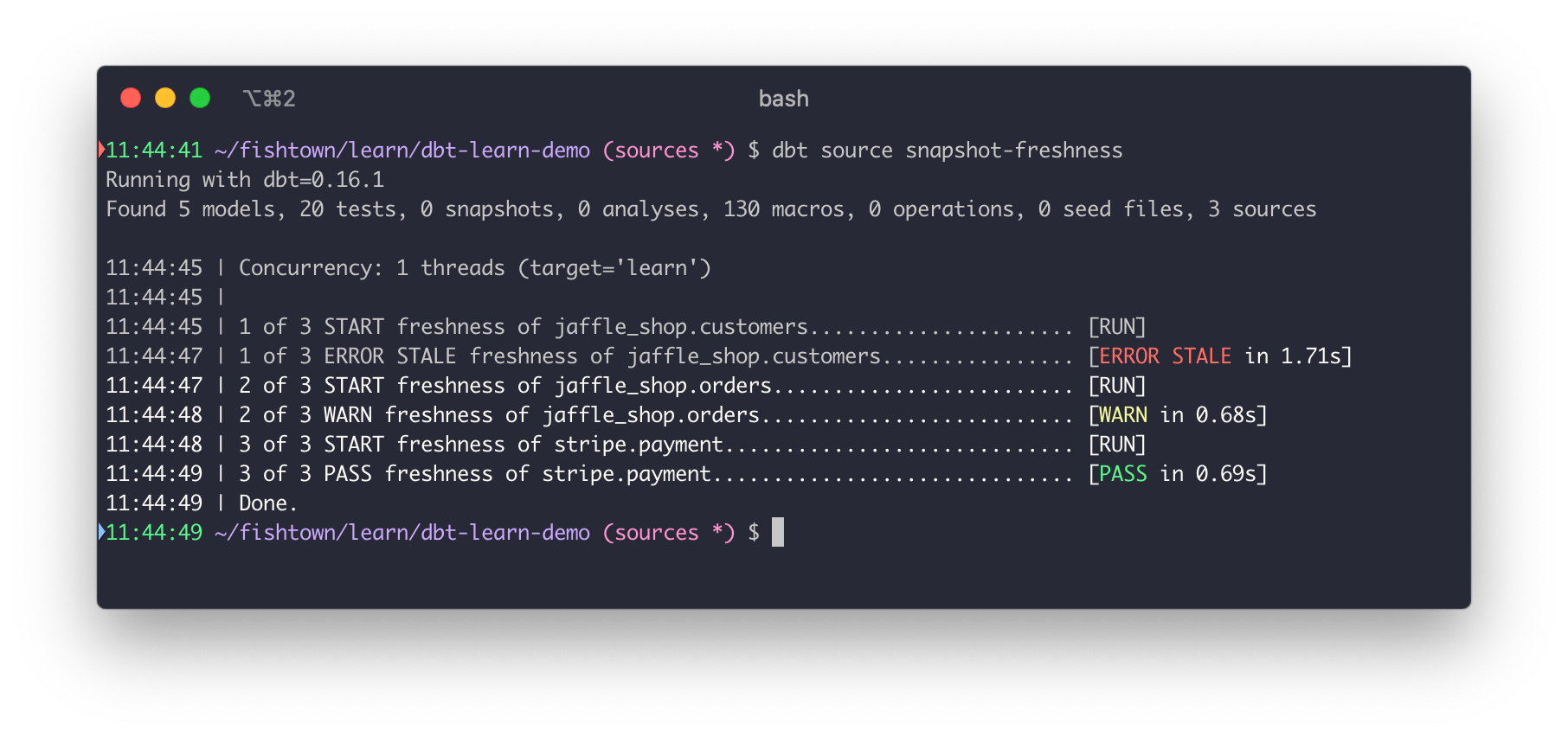Add sources to your DAG
Related reference docs
Using sources
Sources make it possible to name and describe the data loaded into your warehouse by your Extract and Load tools. By declaring these tables as sources in dbt, you can then
- select from source tables in your models using the
{{ source() }}function, helping define the lineage of your data - test your assumptions about your source data
- calculate the freshness of your source data
Declaring a source
Sources are defined in .yml files nested under a sources: key.
sources:
- name: jaffle_shop
database: raw
schema: jaffle_shop
tables:
- name: orders
- name: customers
- name: stripe
tables:
- name: payments
*By default, schema will be the same as name. Add schema only if you want to use a source name that differs from the existing schema.
If you're not already familiar with these files, be sure to check out the documentation on properties.yml files before proceeding.
Selecting from a source
Once a source has been defined, it can be referenced from a model using the {{ source()}} function.
select
...
from {{ source('jaffle_shop', 'orders') }}
left join {{ source('jaffle_shop', 'customers') }} using (customer_id)
dbt will compile this to the full table name:
select
...
from raw.jaffle_shop.orders
left join raw.jaffle_shop.customers using (customer_id)
Using the {{ source () }} function also creates a dependency between the model and the source table.
Testing and documenting sources
You can also:
- Add data tests to sources
- Add descriptions to sources, that get rendered as part of your documentation site
These should be familiar concepts if you've already added data tests and descriptions to your models (if not check out the guides on testing and documentation).
sources:
- name: jaffle_shop
description: This is a replica of the Postgres database used by our app
tables:
- name: orders
database: raw
description: >
One record per order. Includes cancelled and deleted orders.
columns:
- name: id
description: Primary key of the orders table
data_tests:
- unique
- not_null
- name: status
description: Note that the status can change over time
- name: ...
- name: ...
You can find more details on the available properties for sources in the reference section.
FAQs
Source data freshness
With a couple of extra configs, dbt can optionally capture the "freshness" of the data in your source tables. This is useful for understanding if your data pipelines are in a healthy state, and is a critical component of defining SLAs for your warehouse.
Declaring source freshness
To configure source freshness information, add a freshness block to your source and loaded_at_field to your table declaration:
sources:
- name: jaffle_shop
database: raw
config:
freshness: # default freshness
# changed to config in v1.9
warn_after: {count: 12, period: hour}
error_after: {count: 24, period: hour}
loaded_at_field: _etl_loaded_at # changed to config in v1.10
tables:
- name: orders
config:
freshness: # make this a little more strict
warn_after: {count: 6, period: hour}
error_after: {count: 12, period: hour}
- name: customers # this inherits the default freshness defined in the jaffle_shop source block at the beginning
- name: product_skus
config:
freshness: null # do not check freshness for this table
In the freshness block, one or both of warn_after and error_after can be provided. If neither is provided, then dbt will not calculate freshness for the tables in this source.
Additionally, the loaded_at_field is required to calculate freshness for a table (except for cases where dbt can leverage warehouse metadata to calculate freshness). If a loaded_at_field, or viable alternative, is not provided, then dbt will not calculate freshness for the table.
These configs are applied hierarchically, so freshness and loaded_at_field values specified for a source will flow through to all of the tables defined in that source. This is useful when all of the tables in a source have the same loaded_at_field, as the config can just be specified once in the top-level source definition.
Checking source freshness
To obtain freshness information for your sources, use the dbt source freshness command (reference docs):
$ dbt source freshness
Behind the scenes, dbt uses the freshness properties to construct a select query, shown below. You can find this query in the query logs.
select
max(_etl_loaded_at) as max_loaded_at,
convert_timezone('UTC', current_timestamp()) as calculated_at
from raw.jaffle_shop.orders
The results of this query are used to determine whether the source is fresh or not:
Build models based on source freshness
Our best practice recommendation is to use data source freshness. This will allow settings to be transfered into a .yml file where source freshness is defined on model level.
To build models based on source freshness in dbt:
- Run
dbt source freshnessto check the freshness of your sources. - Use the
dbt build --select source_status:fresher+command to build and test models downstream of fresher sources.
Using these commands in order makes sure models update with the latest data. This eliminates wasted compute cycles on unchanged data and builds models only when necessary.
Set source freshness snapshots to 30 minutes to check for source freshness, then run a job which rebuilds every hour to rebuild model. This setup retrieves all the models and rebuild them in one attempt if their source freshness has expired. For more information, refer to Source freshness snapshot frequency.
Filter
Some databases can have tables where a filter over certain columns are required, in order prevent a full scan of the table, which could be costly. In order to do a freshness check on such tables a filter argument can be added to the configuration, for example, filter: _etl_loaded_at >= date_sub(current_date(), interval 1 day). For the example above, the resulting query would look like
select
max(_etl_loaded_at) as max_loaded_at,
convert_timezone('UTC', current_timestamp()) as calculated_at
from raw.jaffle_shop.orders
where _etl_loaded_at >= date_sub(current_date(), interval 1 day)
FAQs
Was this page helpful?
This site is protected by reCAPTCHA and the Google Privacy Policy and Terms of Service apply.

